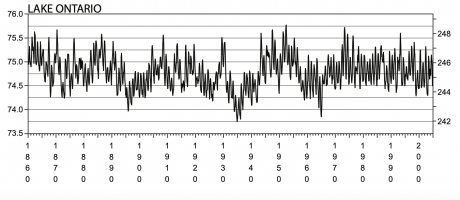In 2017 the water level of Lake Ontario peaked at 248.6 feet above sea level the week of May 26th, highest since recording on a consistent basis began in 1918. In 2019 that record was surpassed the week of June 15th when the level reached 249.1 feet.
Here’s what it looked like that week last year:
What can we look for in 2020? As of the week of April 10th on a year over year basis, Lake Ontario was 247.0 feet above sea level. Last year, it was 246.3 feet. According to the U.S Army Corps of Engineers Weekly update the outlook for May 10 we can expect rise of 11 inches, to 247.9 feet, well above the level the same time last year. Looks like high water is with us for a while.
In 2013, it was a different story. According to an article in the January 21, 2014 journal Geophysical Research Letters:
"The last two decades have been kind of exceptional," said Carl Watras, a climate scientist with the Wisconsin Department of Natural Resources and the University of Wisconsin-Madison. Water levels have been declining since 1998, Watras told Live Science. "Our lakes have never been lower than they are."
Not exactly, although they were low. Lake Ontario at its lowest in 2013 was 243.8 feet above sea level. However, the lowest recorded levels were in the early 1930s, averaging 243.5 feet. The lowest ever since 1919 was in December 1934, 241.9 feet.
The lake came back a decade later, with high waters from the mid 1940s through the early 1950s. In 1947 the peak was 248.3 when a vicious storm took out the pier leaving the 70 year old lighthouse stranded.
It was salvaged and has stood beside the Oakville Yacht Squadron clubhouse since. The peak was 1954, 248.8 feet.
Since the Moses Saunders Power Dam was completed in 1958 at Cornwall/Massena as part of the St. Lawrence Seaway project it appears the lake’s fluctuations have dampened. Following are annual lake level fluctuations since 1918:
Image Credit: US Army Corps of Engineers
For a more detailed version, here’s the link: Great Lakes Water Level Data
But what drives water level fluctuations?
Scientists have discerned an eight year cycle superimposed upon a 12 year cycle, factor in estimated post-glacial isostatic rebounding, the possible effect of dredging on the St Clair River and many other things.
All of which makes our lake rather difficult to predict. And now we have climate change. Is it a factor? It was blamed for the low levels of 2013, and for the high levels of 2017 – 2019.
Only time will tell. But unless we have a drought, and soon, plan for high lake levels in 2020. Having lived near the shores of Lake Ontario since the early 1950s, I can tell you this: sometimes the water is high, sometimes the water is low.

